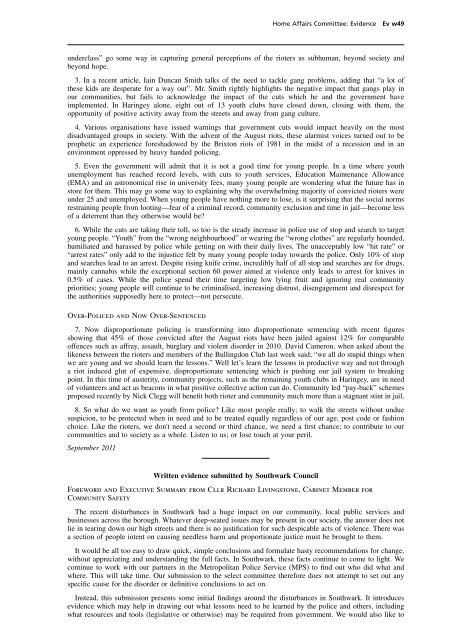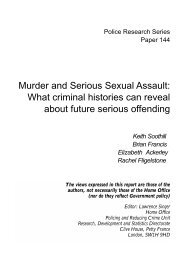Policing Large Scale Disorder: Lessons from the disturbances of ...
Policing Large Scale Disorder: Lessons from the disturbances of ...
Policing Large Scale Disorder: Lessons from the disturbances of ...
Create successful ePaper yourself
Turn your PDF publications into a flip-book with our unique Google optimized e-Paper software.
Home Affairs Committee: Evidence Ev w49<br />
underclass” go some way in capturing general perceptions <strong>of</strong> <strong>the</strong> rioters as subhuman, beyond society and<br />
beyond hope.<br />
3. In a recent article, Iain Duncan Smith talks <strong>of</strong> <strong>the</strong> need to tackle gang problems, adding that “a lot <strong>of</strong><br />
<strong>the</strong>se kids are desperate for a way out”. Mr. Smith rightly highlights <strong>the</strong> negative impact that gangs play in<br />
our communities, but fails to acknowledge <strong>the</strong> impact <strong>of</strong> <strong>the</strong> cuts which he and <strong>the</strong> government have<br />
implemented. In Haringey alone, eight out <strong>of</strong> 13 youth clubs have closed down, closing with <strong>the</strong>m, <strong>the</strong><br />
opportunity <strong>of</strong> positive activity away <strong>from</strong> <strong>the</strong> streets and away <strong>from</strong> gang culture.<br />
4. Various organisations have issued warnings that government cuts would impact heavily on <strong>the</strong> most<br />
disadvantaged groups in society. With <strong>the</strong> advent <strong>of</strong> <strong>the</strong> August riots, <strong>the</strong>se alarmist voices turned out to be<br />
prophetic an experience foreshadowed by <strong>the</strong> Brixton riots <strong>of</strong> 1981 in <strong>the</strong> midst <strong>of</strong> a recession and in an<br />
environment oppressed by heavy handed policing.<br />
5. Even <strong>the</strong> government will admit that it is not a good time for young people. In a time where youth<br />
unemployment has reached record levels, with cuts to youth services, Education Maintenance Allowance<br />
(EMA) and an astronomical rise in university fees, many young people are wondering what <strong>the</strong> future has in<br />
store for <strong>the</strong>m. This may go some way to explaining why <strong>the</strong> overwhelming majority <strong>of</strong> convicted rioters were<br />
under 25 and unemployed. When young people have nothing more to lose, is it surprising that <strong>the</strong> social norms<br />
restraining people <strong>from</strong> looting—fear <strong>of</strong> a criminal record, community exclusion and time in jail—become less<br />
<strong>of</strong> a deterrent than <strong>the</strong>y o<strong>the</strong>rwise would be?<br />
6. While <strong>the</strong> cuts are taking <strong>the</strong>ir toll, so too is <strong>the</strong> steady increase in police use <strong>of</strong> stop and search to target<br />
young people. “Youth” <strong>from</strong> <strong>the</strong> “wrong neighbourhood” or wearing <strong>the</strong> “wrong clo<strong>the</strong>s” are regularly hounded,<br />
humiliated and harassed by police while getting on with <strong>the</strong>ir daily lives. The unacceptably low “hit rate” or<br />
“arrest rates” only add to <strong>the</strong> injustice felt by many young people today towards <strong>the</strong> police. Only 10% <strong>of</strong> stop<br />
and searches lead to an arrest. Despite rising knife crime, incredibly half <strong>of</strong> all stop and searches are for drugs,<br />
mainly cannabis while <strong>the</strong> exceptional section 60 power aimed at violence only leads to arrest for knives in<br />
0.5% <strong>of</strong> cases. While <strong>the</strong> police spend <strong>the</strong>ir time targeting low lying fruit and ignoring real community<br />
priorities; young people will continue to be criminalised, increasing distrust, disengagement and disrespect for<br />
<strong>the</strong> authorities supposedly here to protect—not persecute.<br />
Over-Policed and Now Over-Sentenced<br />
7. Now disproportionate policing is transforming into disproportionate sentencing with recent figures<br />
showing that 45% <strong>of</strong> those convicted after <strong>the</strong> August riots have been jailed against 12% for comparable<br />
<strong>of</strong>fences such as affray, assault, burglary and violent disorder in 2010. David Cameron, when asked about <strong>the</strong><br />
likeness between <strong>the</strong> rioters and members <strong>of</strong> <strong>the</strong> Bullingdon Club last week said; “we all do stupid things when<br />
we are young and we should learn <strong>the</strong> lessons.” Well let’s learn <strong>the</strong> lessons in productive way and not through<br />
a riot induced glut <strong>of</strong> expensive, disproportionate sentencing which is pushing our jail system to breaking<br />
point. In this time <strong>of</strong> austerity, community projects, such as <strong>the</strong> remaining youth clubs in Haringey, are in need<br />
<strong>of</strong> volunteers and act as beacons in what positive collective action can do. Community led “pay-back” schemes<br />
proposed recently by Nick Clegg will benefit both rioter and community much more than a stagnant stint in jail.<br />
8. So what do we want as youth <strong>from</strong> police? Like most people really; to walk <strong>the</strong> streets without undue<br />
suspicion, to be protected when in need and to be treated equally regardless <strong>of</strong> our age, post code or fashion<br />
choice. Like <strong>the</strong> rioters, we don't need a second or third chance, we need a first chance; to contribute to our<br />
communities and to society as a whole. Listen to us; or lose touch at your peril.<br />
September 2011<br />
Written evidence submitted by Southwark Council<br />
Foreword and Executive Summary <strong>from</strong> Cllr Richard Livingstone, Cabinet Member for<br />
Community Safety<br />
The recent <strong>disturbances</strong> in Southwark had a huge impact on our community, local public services and<br />
businesses across <strong>the</strong> borough. Whatever deep-seated issues may be present in our society, <strong>the</strong> answer does not<br />
lie in tearing down our high streets and <strong>the</strong>re is no justification for such despicable acts <strong>of</strong> violence. There was<br />
a section <strong>of</strong> people intent on causing needless harm and proportionate justice must be brought to <strong>the</strong>m.<br />
It would be all too easy to draw quick, simple conclusions and formulate hasty recommendations for change,<br />
without appreciating and understanding <strong>the</strong> full facts. In Southwark, <strong>the</strong>se facts continue to come to light. We<br />
continue to work with our partners in <strong>the</strong> Metropolitan Police Service (MPS) to find out who did what and<br />
where. This will take time. Our submission to <strong>the</strong> select committee <strong>the</strong>refore does not attempt to set out any<br />
specific cause for <strong>the</strong> disorder or definitive conclusions to act on.<br />
Instead, this submission presents some initial findings around <strong>the</strong> <strong>disturbances</strong> in Southwark. It introduces<br />
evidence which may help in drawing out what lessons need to be learned by <strong>the</strong> police and o<strong>the</strong>rs, including<br />
what resources and tools (legislative or o<strong>the</strong>rwise) may be required <strong>from</strong> government. We would also like to
















